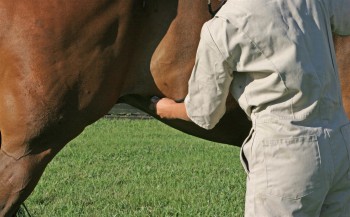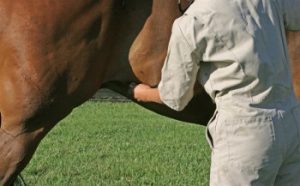Horse gut sounds and what they mean

 One way to determine if your horse is normal and healthy is to evaluate the rumblings of his gut. The technical term for a gut sound is a borborygmus (pronounced bôr′bə-rĭg′məs). The plural is borborygmi. During a physical exam a veterinarian will listen to your horse’s gut sounds with a stethoscope in the flank area to determine if normal borborygmi are present. When listening for gut sounds, both sides of the horse are evaluated and the abdomen is divided into four areas or quadrants. A healthy horse will have consistent and active rumblings in each of the four quadrants. Each area should be evaluated for at least one minute. As a general rule, it is normal to hear 1 to 3 borborygmi in a 60-second period. If less than 1 borborygmus is heard per minute then that portion of the gut is noted as hypomotile (not enough movement). If more than 3 borborygmi are heard per minute the area is noted as hypermotile (too much movement). Of course, there are variations depending on the individual horse and when he or she last ate.
One way to determine if your horse is normal and healthy is to evaluate the rumblings of his gut. The technical term for a gut sound is a borborygmus (pronounced bôr′bə-rĭg′məs). The plural is borborygmi. During a physical exam a veterinarian will listen to your horse’s gut sounds with a stethoscope in the flank area to determine if normal borborygmi are present. When listening for gut sounds, both sides of the horse are evaluated and the abdomen is divided into four areas or quadrants. A healthy horse will have consistent and active rumblings in each of the four quadrants. Each area should be evaluated for at least one minute. As a general rule, it is normal to hear 1 to 3 borborygmi in a 60-second period. If less than 1 borborygmus is heard per minute then that portion of the gut is noted as hypomotile (not enough movement). If more than 3 borborygmi are heard per minute the area is noted as hypermotile (too much movement). Of course, there are variations depending on the individual horse and when he or she last ate.
Typically when a horse presents with impending enterocolitis, which often results in diarrhea, he will have a hypermotile gut with increased liquid and gas sounds. Hypermotility can be present in the early stages of obstructive disease. Hypomotility, however, is the sign of a poor gut movement and an absence of gut sounds may indicate the presence of an obstruction.
What lies below the stethoscope?
The upper left quadrant of the horse’s flank overlies the pelvic flexure of the large intestine and small colon. Referred sounds from the stomach and small intestine can be heard, depending on gut fill. This quadrant can be quieter than others because it typically contains smaller quantiles of fluid and gas, but sounds should still be present.
The lower left quadrant overlies the left upper and lower colon. The upper right quadrant overlies the base of the cecum, and the lower right quadrant overlies the body of the cecum. Constant motility and large quantities of fluid and gas are expected to be found in these quadrants. Sounds should be consistent and of a greater intensity than those heard in the upper left quadrant.
It can be helpful for owners to learn how to listen for gut sounds and to know what is normal for their horse. It is important to become familiar with some of the other passive sounds that might be heard in the gut so as not to mistake them for proper intestinal function. Ask your veterinarian to help you learn how to use and position the stethoscope properly and what to listen for. Check your horse periodically to learn what is normal for him or her. Borborygmi alone cannot be used to identify an illness; a complete physical exam and the review of other symptoms are necessary to properly diagnose and treat diseases of the gastrointestinal tract.
Article written by KPP staff.
Copyright (C) 2015 Kentucky Performance Products, LLC. All rights reserved.
